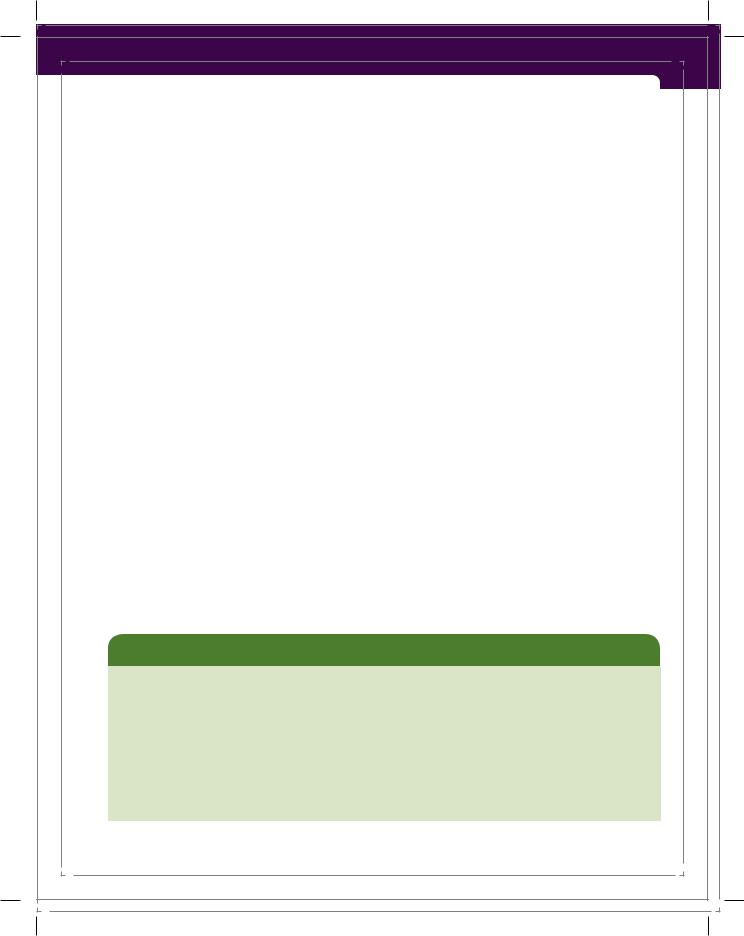
Introduction to Bioethics
.pdf
INTRODUCTION TO |
2 |
BIOETHICS AND ETHICAL |
|
DECISION MAKING |
|
KAREN L. RICH |
Photo/Shutterstock WDG ©
The tiniest hair casts a shadow.
—Johann Wolfgang von Goethe, German poet and dramatist (1749–1832)
Introduction to Bioethics
The terms bioethics and healthcare ethics sometimes are used interchangeably. Bioethics, born out of the rapidly expanding technical environment of the 1900s, is a specifi c domain of ethics focused on moral issues in the fi eld of health care (see Box 2-1). During World War II President Franklin D. Roosevelt assembled a committee to improve medical scientists’ coordination in addressing the medical needs of the military (Jonsen, 2000). As often happens with wartime research and advancements, the work aimed at addressing military needs also affected civilian sectors, such as the fi eld of medicine.
Between 1945 and 1965, antibiotic, antihypertensive, antipsychotic, and cancer drugs came into common medical use; surgery entered the heart and the brain; organ transplantation was initiated; and life-sustaining mechanical devices, the dialysis machine, the pacemaker, and the ventilator were
invented. (Jonsen, 2000, p. 99)
OBJECTIVES
After reading this chapter, the reader should be able to do the following:
4. |
Discuss the history of bioethics. |
7. |
Identify criteria that define an ethical dilemma. |
5. |
Use the approach of ethical principlism in nursing |
8. |
Consider how critical thinking is used in ethical |
|
practice. |
|
nursing practice. |
6. |
Analyze bioethical issues in practice and from news |
9. |
Use selected models of reflection and decision |
|
media. |
|
making in ethical nursing practice. |
33
9781284077223_CH02_033_070.indd 33 |
09/03/15 8:06 pm |

34 |
Chapter 2 Introduction to Bioethics and Ethical Decision Making |
Box 2-1 Early Events in Bioethics
August 19, 1947: The Nuremberg trials of Nazi doctors who conducted heinous medical experiments during World War II began.
April 25, 1953: Watson and Crick published a one-page paper about DNA.
December 23, 1954: The first renal transplant was performed.
March 9, 1960: Chronic hemodialysis was first used.
December 3, 1967: The first heart transplant was done by Dr. Christiaan Barnard.
August 5, 1968: The definition of brain death was developed by an ad hoc committee at Harvard Medical School.
July 26, 1972: Revelations appeared about the unethical Tuskegee syphilis research.
January 22, 1973: The landmark Roe v. Wade case was decided.
April 14, 1975: A comatose Karen Ann Quinlan was brought to Newton Memorial Hospital; she became the basis of a landmark legal case about the removal of life support.
July 25, 1978: Baby Louise Brown was born. She was the first test-tube baby.
Spring 1982: Baby Doe became the basis of a landmark case that resulted in legal and ethical directives about the treatment of impaired neonates.
December 1982: The first artificial heart was implanted into the body of Barney Clark, who lived 112 days after the implant.
April 11, 1983: Newsweek published a story that a mysterious disease called AIDS was at epidemic levels.
Source: Jonsen, A. R. (2000). A short history of medical ethics. New York, NY: Oxford University Press, pp. 99–114.
However, with these advances also came increased responsibility and distress among healthcare professionals. Patients who would have died in the past began to have a lingering, suffering existence. Healthcare professionals were faced with trying to decide how to allocate newly developed, scarce medical resources. During the 1950s scientists and medical professionals began meeting to discuss these confusing problems. Eventually healthcare policies and laws were enacted to address questions of who lives, who dies, and who decides. A new field of study was developed called bioethics, a term that first appeared in the literature in 1969 (Jonsen, 1998, 2000, 2005).
Ethical Principles
Because shocking information surfaced about serious ethical lapses, such as the heinous World War II Nazi medical experiments in Europe and the unethical Tuskegee research in the United States, societies around the world became particularly conscious of ethical pitfalls in conducting biomedical and behavioral research. In the United States, the National Research Act became law in 1974,
9781284077223_CH02_033_070.indd 34 |
09/03/15 8:06 pm |

Ethical Principles |
35 |
Research Note: Tuskegee Syphilis Study
During the late 1920s in the United States, syphilis rates were extremely high in some areas. The private Rosenwald Foundation teamed with the United States Public Health Service (USPHS) to begin efforts to control the disease using the drug neosalvarsan, an arsenic compound. Macon County, Alabama, particularly the town of Tuskegee, was targeted because of its high rate of syphilis, as identified through a survey. However, the Great Depression derailed the plans, and the private foundation withdrew from the work. The USPHS repeated the Rosenwald survey in Macon County and identified a syphilis rate of 22% among African American men in the county and a 62% rate of congenital syphilis cases. The natural history (progression) of syphilis had not been studied yet in the United States, and the surgeon general suggested that 399 African American men with syphilis in Tuskegee should be observed, rather than treated, and compared with a group of 200 African American men who were uninfected. The men were not told about the particular details of their disease. They underwent painful, nontherapeutic spinal taps to provide data about the natural history of syphilis and were told these procedures were treatments for “bad blood.” The men were given free meals, medical
treatment for diseases other than their syphilis, and free burials. Even after penicillin was discovered in the 1940s, the men were not offered treatment. In fact, the USPHS researchers arranged to keep the uninformed study participants out of World War II because the men would be tested for syphilis, treated with penicillin, and lost from the study. The unethical research continued for 40 years, from 1932 to 1972. During the 40 years of research, an astonishing number of articles about the study were published in medical journals and no attempt was made to hide the surreptitious terms of the research. No one intervened to stop the travesty. Finally, a medical reporter learned of the study and the ethical issues were exposed.
After reading this chapter and researching more information on the Internet about the Tuskegee research, especially the contribution of Nurse Evers, answer the following questions:
1.What were the main social issues with ethical implications involved in this study?
2.Which bioethical principles were violated by the Tuskegee study? Explain.
3.How do various ethical approaches relate to the Tuskegee study? (See Chapter 1)
4.Which procedures are in place today to prevent this type of unethical research?
and a commission was created to outline principles that must be used during research involving human subjects (National Institutes of Health, 1979). In 1976, to carry out their charge, the commission held an intensive 4-day meeting at the Belmont Conference Center at the Smithsonian Institute. Thereafter, discussions continued until 1978, when the commission released its report called the Belmont Report.
The report outlined three basic principles for all human subjects research: respect for persons, beneficence, and justice (National Institutes of Health, 1979). The principle of beneficence, as set forth in the Belmont Report, is the rule
9781284077223_CH02_033_070.indd 35 |
09/03/15 8:06 pm |

36 |
Chapter 2 Introduction to Bioethics and Ethical Decision Making |
to do good. However, the description of beneficence also included the rule now commonly known as the principle of nonmaleficence—that is, to do no harm. The report contained guidelines regarding how to apply the principles in research through informed consent, the assessment of risks and benefits to research participants, and the selection of research participants.
In 1979, as an outgrowth of the Belmont Report, Beauchamp and Childress published the first edition of their book Principles of Biomedical Ethics, which featured four bioethical principles: autonomy, nonmaleficence, beneficence, and justice. Currently the book is in its seventh edition, and the principle of auto nomy is described as respect for autonomy.
Doing ethics based on the use of principles—that is, ethical principlism— does not involve the use of a theory or a formal decision-making model; rather, ethical principles provide guidelines to make justified moral decisions and to evaluate the morality of actions. Ideally, when using the approach of principlism, no one principle should automatically be assumed to be superior to the other principles (Beauchamp & Childress, 2013). Each principle is considered to be prima facie binding.
Some people have criticized the use of ethical principlism because they believe it is a top-down approach that does not include allowances for the context of individual cases and stories. Critics contend that simply applying principles when making ethical determinations results in a linear way of doing ethics—that is, the fine nuances present in relationship-based situations are not considered adequately. Nevertheless, the approach of ethical principlism using the four principles outlined by Beauchamp and Childress (2013) has become one of the most popular tools used today for analyzing and resolving bioethical problems.
Autonomy
Autonomy is the freedom and ability to act in a self-determined manner. It represents the right of a rational person to express personal decisions independent of outside interference and to have these decisions honored. It can be argued that autonomy occupies a central place in Western healthcare ethics because of the popularity of the Enlightenment-era philosophy of Immanuel Kant. However, it is noteworthy that autonomy is not emphasized in an ethic of care and virtue ethics, and these also are popular approaches to ethics today.
The principle of autonomy sometimes is described as respect for autonomy (Beauchamp & Childress, 2013). In the domain of health care, respecting a patient’s autonomy includes obtaining informed consent for treatment; facilitating and supporting patients’ choices regarding treatment options; allowing
9781284077223_CH02_033_070.indd 36 |
09/03/15 8:06 pm |

Autonomy |
37 |
patients to refuse treatments; disclosing comprehensive and truthful information, diagnoses, and treatment options to patients; and maintaining privacy and confidentiality. Respecting autonomy also is important in less obvious situations, such as allowing home care patients to choose a tub bath versus a shower when it is safe to do so and allowing an elderly long-term care resident to choose her favorite foods when they are medically prescribed. In fact, if the elder is competent and has been properly informed about the risks, she has the right to choose to eat foods that are not medically prescribed. Restrictions on an individual’s autonomy may occur in cases when a person presents a potential threat for harming others, such as exposing other people to communicable diseases or committing acts of violence; people generally lose the right to exercise autonomy or self-determina- tion in such instances.
Respecting patients’ autonomy is important, but it also is important for nurses to receive respect for their professional autonomy. In considering how the language nurses choose defines the profession’s place in health care, Munhall (2012) used the word autonomy (auto-no-my) as an example. She reflected on how infants and children first begin to express themselves through nonverbal signs, such as laughing, crying, and pouting, but by the time children reach the age of 2 years, they usually “have learned to treasure the word no” (p. 40). Munhall calls the word no “one of the most important words in any language” (p. 40). Being willing and able to say no is part of exercising one’s autonomy.
■■ Informed Consent
Informed consent in regard to a patient’s treatment is a legal, and ethical, issue of autonomy. At the heart of informed consent is respecting a person’s autonomy to make personal choices based on the appropriate appraisal of information about the actual or potential circumstances of a situation (see Box 2-2). Though all conceptions of informed consent must contain the same basic elements,
Box 2-2 Elements of Informed Consent
I.Threshold elements (preconditions)
1.Competence (to understand and decide)
2.Voluntariness (in deciding) II. Information elements
3.Disclosure (of material information)
4.Recommendation (of a plan)
5.Understanding (of 3 and 4)
III.Consent elements
6.Decision (in favor of a plan)
7.Authorization (of the chosen plan)
Source: Beauchamp, T. L., & Childress, J. F. (2013).
Principles of biomedical ethics (7th ed.). New York, NY: Oxford University Press, p. 124.
9781284077223_CH02_033_070.indd 37 |
09/03/15 8:06 pm |

38 |
Chapter 2 Introduction to Bioethics and Ethical Decision Making |
the description of these elements is presented differently by different people. Beauchamp and Childress (2013) outlined informed consent according to seven elements. Dempski (2009) presented three basic elements that are necessary for informed consent to occur:
1.Receipt of information: This includes receiving a description of the procedure, information about the risks and benefits of having or not having the treatment, reasonable alternatives to the treatment, probabilities about outcomes, and “the credentials of the person who will perform the treatment” (Dempski, 2009, p. 78). Because it is too demanding to inform a patient of every possible risk or benefit involved with every treatment or procedure, the obligation is to inform the person about the information a reasonable person would want and need to know. Information should be tailored specifically to a person’s personal circumstances, including providing information in the person’s spoken language.
2.Consent for the treatment must be voluntary: A person should not be under any influence or be coerced to provide consent. This means patients should not be asked to sign a consent form when they are under the influence of mind-altering medications, such as narcotics. Depending on the circumstances, consent may be verbalized, written, or implied by behavior. Silence does not convey consent when a reasonable person would normally offer another sign of agreement.
3.Persons must be competent: Persons must be able to communicate consent and to understand the information provided to them. If a person’s condition warrants transferring decision-making authority to a surrogate, informed consent obligations must be met with the surrogate.
Legal Perspective |
It is neither ethical nor legal for a nurse to be respon- |
|
sible for obtaining informed consent for procedures per- |
||
|
||
|
formed by a physician (Dempski, 2009). Nurses may need |
|
Nurses should not obtain informed |
to display the virtue of courage if physicians attempt |
|
consent for a provider who will |
to delegate this responsibility to them. Though both |
|
perform a patient’s invasive pro- |
nurses and physicians in some circumstances may believe |
|
cedure. However, nurses may be |
nurses are well versed in assuring that the elements of |
|
legally liable if they know or should |
informed consent are met for medical or surgical inva- |
|
have known informed consent was |
sive treatments or procedures performed by a physician, |
not obtained and if nurses do not |
nurses must refrain from accepting this responsibility. On |
|
appropriately notify providers or |
||
the other hand, it is certainly within a nurse’s domain of |
||
supervisors about this deficiency. |
||
responsibility to help identify a suitable person to provide |
||
|
||
|
informed consent if a patient is not competent; to verify |
|
that a patient understands the information communicated, including helping |
||
9781284077223_CH02_033_070.indd 38 |
09/03/15 8:06 pm |

Autonomy |
39 |
to secure interpreters or appropriate information for the patient in the patient’s spoken language; and to notify appropriate parties if the nurse knows a patient has not given informed consent for a procedure or treatment. In fact, it is ethically incumbent upon nurses to facilitate patients’ opportunities to give informed consent.
Advanced-practice nurses are legally and ethically obligated to obtain informed consent before performing risky or invasive treatments or procedures within their scope of practice. In everyday situations all nurses are required to explain nursing treatments and procedures to patients before performing them. If a patient understands the treatment or procedure and allows the nurse to begin the nursing care, consent has been implied. Nursing procedures do not need to meet all of the requirements of informed consent if procedures are not risky or invasive (Dempski, 2009).
Legal Perspective
Assault and battery are two legal terms describing offenses against a person. Both are relevant to the ethical requirement of informed consent. Assault is the threat of harm; for example, someone commits assault if he or she acts or talks in a way that causes another person to feel apprehension about his or her physical safety. Battery consists of one person offensively touching another person.
■■ Intentional Nondisclosure
In the past, medical and nursing patient-care errors were something to be swept under the rug, and care was taken to avoid patient discovery of these errors. However, when healthcare leaders realized that huge numbers of patients, as many as 98,000 per year, were dying from medical errors, the Institute of Medicine (IOM) began a project to analyze medical errors and try to reduce them. One outcome of the project is the book To Err Is Human: Building a Safer Health Care System (IOM, 2000). The IOM project committee determined that to err really is human, and good people working within unsafe systems make the most errors.
It is now expected that errors involving serious, preventable adverse events be reported to patients and other organizational reporting systems on a mandatory basis (IOM, 2000). Reporting near misses (i.e., errors that cause no harm to patients) are more controversial (Lo, 2009). Some professionals tend to avoid telling patients about near-miss errors since no harm was done to the patient, but ethicists recommend disclosure of these events. Being honest and forthright with patients promotes trust, and secrecy is unethical (Jonsen, Siegler, & Winslade, 2010).
Intentionally not disclosing information to a patient or surrogate is legal in situations of emergency or when patients waive their right to be informed. Respecting a patient’s right not to be informed is especially important in culturally sensitive care. Other more legally and ethically controversial circumstances of intentionally not disclosing relevant information to a patient involve three
9781284077223_CH02_033_070.indd 39 |
09/03/15 8:06 pm |

40 |
Chapter 2 Introduction to Bioethics and Ethical Decision Making |
healthcare circumstances (Beauchamp & Childress, 2013). The first circumstance falls under therapeutic privilege. The second relates to therapeutically using placebos. The third involves withholding information from research subjects to protect the integrity of the research.
Invoking therapeutic privilege allows physicians to withhold information from patients if physicians, based on their sound medical judgment, believe “divulging the information would potentially harm a depressed, emotionally drained, or unstable patient” (Beauchamp & Childress, 2013, p. 127). There are various standards about what constitutes therapeutic privilege in different legal jurisdictions. Standards range from withholding information if the physician believes the information would have any negative effect on the patient’s health condition to withholding information only if divulging it is likely to have a serious effect.
Placebos, when used therapeutically, are inactive substances given to a patient in an attempt to induce a positive health outcome through the patient’s belief that the inert substance really carries some beneficial power. The patient is unaware that the substance (placebo) is inactive. It is interesting that at least one study has shown placebos can have a positive effect in a majority of patients, even when the patients know they are receiving an inert pill (Scuderi, 2011). Proponents of using placebos say the action is covered under a patient’s general consent to treatment, though the consent is not entirely informed. However, there is a general consensus that the therapeutic use of placebos is unethical (Jonsen et al., 2010) because it violates a patient’s autonomy and can seriously damage trust between patients and healthcare professionals. The use of placebos is ethical when used properly during experimental research. Participants in a research control group often are given a placebo so they can be compared to an experimental group receiving the treatment being studied. Research participants are fully informed that they may receive a placebo rather than the actual treatment.
Strict rules apply to research studies requiring that research subjects be protected from manipulation and personal risks. Thus, informed consent in research has stringent requirements. Withholding information from research subjects should never be undertaken lightly. Intentional nondisclosure sometimes is allowed only if the research is relatively risk-free to the participants and when the nature of the research is behavioral or psychological and disclosure might seriously skew the outcomes of the research.
■■ Patient Self-Determination Act
The Patient Self-Determination Act (PSDA), passed by the U.S. Congress in 1990, is the first federal statute designed to facilitate a patient’s autonomy through the knowledge and use of advance directives. Healthcare providers and
9781284077223_CH02_033_070.indd 40 |
09/03/15 8:06 pm |

Autonomy |
41 |
organizations must provide written information to adult patients regarding state laws covering the right to make healthcare decisions, to refuse or withdraw treatments, and to write advance directives. One of the underlying aims of the PSDA is to increase meaningful dialogue about patients’ rights to make autonomous choices about receiving or not receiving health care.
It is important that dialogue about end-of-life decisions and options are not lost in organizational admission processes, paperwork, and other ways. Nurses provide the vital communication link between the patient’s wishes, the paperwork, and the provider. When an appropriate opportunity arises, nurses need to take an active role in increasing their dialogue with patients in regard to patients’ rights and end-of-life decisions. In addition to responding to the direct questions patients and families ask about advance directives and end-of-life options, nurses would do well to listen and observe patients’ subtle cues signaling their anxiety and uncertainty about end-of-life care. A good example of compassionate care is when nurses actively listen to patients and try to alleviate patients’ uncertainty and fears in regard to end-of-life decision making.
■■The Health Insurance Portability and Accountability Act of 1996 (HIPAA) Privacy
and Security Rules
“Within HHS [Health and Human Services], the Office for Civil Rights (OCR) has responsibility for enforcing the [HIPAA] Privacy and Security Rules with voluntary compliance activities and civil money penalties” (U.S. Department of Health and Human Services [HHS], n.d.b, para. 2). The HIPAA Privacy Rule is a federal regulation designed to protect people from disclosure of their personal health information other than for the provision of health care and for other need-to-know purposes on a minimum necessary basis (HHS, n.d.c; HHS, 2003). The intent of the rule is to ensure privacy while facilitating the flow of information necessary to meet the needs of patients.
The Privacy Rule protects all “individually identifiable health information” held or transmitted by a covered entity or its business associate, in any form or media, whether electronic, paper, or oral. The Privacy Rule calls this information “protected health information (PHI)” (45 C.F.R. § 160.103 as cited in HHS, 2003, p. 3).
The Security Rules of the act operationalize the Privacy Rules. These rules contain standards addressing privacy safeguards for electronic protected health information (HHS, n.d.b). The rule is designed to “assure the confidentiality, integrity, and availability of electronic protected health information” (HHS, n.d.b, para. 2).
9781284077223_CH02_033_070.indd 41 |
09/03/15 8:06 pm |

42 |
Chapter 2 Introduction to Bioethics and Ethical Decision Making |
All patient-identifiable protected health information is to be kept private unless it is being used for patient care, a patient agrees to a release, or it is released according to legitimate, limited situations covered by the act. It is incumbent on all healthcare professionals to be familiar with the content of the act. Other special health information privacy issues addressed by the HHS (n.d.a) include the following:
•Public health: There is sometimes a legitimate need to release medical information for the protection of public health.
•Research: Private information is protected, but processes are used to allow researchers to conduct well-designed studies.
•Emergency preparedness: As with other public health issues, access to protected information sometimes is allowed to facilitate emergency preparedness.
•Health information technology: The confidential maintenance and exchange of information via electronic formats is supported by the act.
•Genetic information: The Genetic Information Nondiscrimination Act (GINA) of 2008 identifies genetic information as health information and requires Privacy Rule modifications to ensure that no one is discriminated against in employment or for insurance coverage based on genetic information.
Nonmaleficence
Nonmaleficence is the principle used to communicate the obligation to do no harm. Emphasizing the importance of this principle is as old as organized medical practice. Healthcare professionals have historically been encouraged to do good (beneficence), but if for some reason they cannot do good, they are required to at least do no harm. Because of the two sides of the same coin connotation between these two principles, some people consider them to be essentially one and the same. However, many ethicists, including Beauchamp and Childress (2013), do make a distinction.
Nonmaleficence is the maxim or norm that “one ought not to inflict evil or harm” (Beauchamp & Childress, 2013, p. 152), whereas beneficence includes the following three norms: “one ought to prevent evil or harm, one ought to remove evil or harm, [and] one ought to do or promote good” (p. 152). As evidenced by these maxims, beneficence involves action to help someone and nonmaleficence requires “intentional avoidance of actions that cause harm” (p. 152). In addition to violating the maxim to not intentionally harm another person, some of the
9781284077223_CH02_033_070.indd 42 |
09/03/15 8:06 pm |
